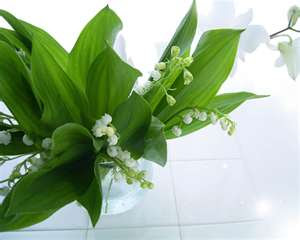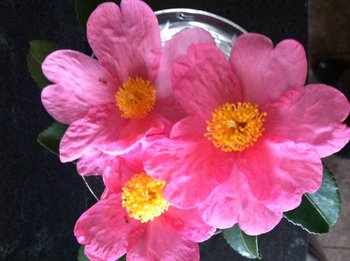Louisiana gardeners seldom grow columbines (Aquilegia species and hybrids) in their cool-season flower gardens. This probably is due mostly to unfamiliarity with columbines -- there is no tradition of using columbines here in the Deep South -- and lack of availability in local nurseries.
Enlarge The Times-Picayune Swan Blue and White Swan series columbine gallery (5 photos)
That's about to change. A relatively new hybrid columbine, called the Swan series, has performed so well in LSU AgCenter trials it has been named a Louisiana Super Plants selection for fall 2011.
Columbines are among the most graceful of garden flowers. The foliage is lacy and bluish-green, and reminds me of large maidenhair fern fronds. The slightly nodding flowers are complexly formed and often include two contrasting colors.
A notable feature of the flowers is the long spurs that extend behind the petals. These claw-like spurs reminded people of the claws of eagles, and that's how this plant got the Latin name Aquilegia, which is derived from the Latin for eagle (aquila). Interestingly, the common name -- columbine -- is derived from the Latin name for another bird, the pigeon or dove (columba).
Swan series columbine
The word "series" has a different meaning from the more commonly used terms "variety" or "cultivar."
All of the plants that belong to a particular variety look exactly the same or very similar: they all have the same, shape, size and color of leaves and flowers and grow to be the same size.
A series, on the other hand, is the result of a focused breeding program that produces closely related but different varieties of a particular plant. These varieties have been bred to be very similar to each other except for a particular characteristic, such as flower color.
So when creating a series, plant breeders develop several individual varieties of a particular plant that share many common traits, such as genetic background, size of plant, growth habit, cultural needs, size and shape of flower and time of bloom. But the varieties differ from one another in one or two significant characteristics -- typically flower color. Within the series, each group is a separate variety and gets its own variety name.
This is the case with the Swan series columbines. The varieties in the Swan series are all very similar in everything except flower color.
Within the Swan series, the varieties are named based on the flower color, and include Swan Blue and White, Swan White, Swan Yellow, Swan Pink and Yellow, Swan Burgundy and White, Swan Violet and White, Swan Rose and White and Swan Red and White.
The outstanding range of beautiful colors is one reason the Swan series was chosen as a Louisiana Super Plants selection. The flowers are also larger than other columbines, and the plants are more vigorous in growth.
Growing swan columbines
In milder climates with cooler summers, columbines may be short-lived perennials that tend to bloom in summer.
Here in Louisiana, however, we grow virtually all columbines (other than Hinckley's columbine) as cool-season annuals that begin blooming in the spring and are removed when they finish blooming in early summer.
Transplants of Swan columbines available at your local nurseries should be purchased and planted now and through the fall. Fall planting allows for the most spectacular floral display in the spring.
Planting can be done all winter and as late as the end of February and still produce excellent results. Plants in 4-inch pots are a great size to plant in fall because they are economical, and the plants have all winter to grow and develop.
Larger sizes often will be available and are especially good when more immediate impact is desired or when planting later in the season.
Typically, the plants you plant in the fall or winter will not be in bloom. Columbines grow over the winter in the garden and bloom in the spring.
Don't let this deter you from planting them. During winter, they produce mounds of attractive foliage that looks great with other cool-season bedding plants, such as pansies and dianthus.
In the spring, generally from March through April or early May, the plants send up stems with clusters of large, elegant, colorful flowers. By May, the plants will be finished flowering and can be removed from the garden (compost them) and replaced with summer bedding plants.
Swan columbines grow well in full sun to part shade. They are one of the few cool-season bedding plants that blooms well in part shade (as does another Louisiana Super Plant, Camelot series foxglove).
Enrich the bed where they are planted by incorporating generous amounts of compost or other organic materials and a light sprinkling of general purpose fertilizer into the soil.
Space Swan columbine transplants about 12 inches apart from the center of one plant to the center of the plant next to it.
Hinckley's columbine
Columbines aren't entirely unheard-of in the New Orleans area. The New Orleans Botanical Garden in City Park has introduced gardeners to a columbine that actually survives as a short-lived perennial here.
The yellow-flowering Hinckley's columbine (Aquilegia chrysantha var. hinckleyana) is native to just one county in western Texas. It has been grown at the Botanical Garden and sold at their plant sales for the past 15 or 20 years, and you see this plant occasionally in area gardens.
Hinckley's columbine blooms with bright yellow flowers in spring and early summer and generally survives for two or three years, sometimes more. New plants are grown from seeds as needed to replace old plants as they die.
Hinckley's columbine thrives in well-drained, partially shaded locations and is drought-tolerant despite its delicate appearance.
Try Super Plants
The purpose of the Louisiana Super Plants program is to identify superior plants for Louisiana landscapes, make sure wholesale growers are growing and retail nurseries are carrying the selections and get the word out to the gardening public about these outstanding plants.
In addition to Swan series columbine, there are two other selections for fall 2011: Redbor kale and Belinda's Dream rose. These plants were featured in earlier columns.
To see photos and read about all of the beautiful and reliable Louisiana Super Plants selections, check out the Louisiana Super Plants website at www.lsuagcenter.com/superplants.
You will also find a list of nurseries in your area that are carrying Louisiana Super Plants.













